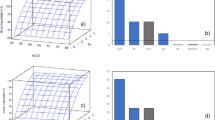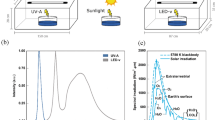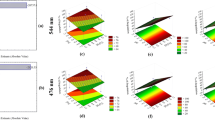Abstract
The food industry is considered to be one of the greatest sources of environmental contamination produced by dyes. Moreover, a large number of commercial food dyes and their by-products have been shown to be toxic, having chronic effects on human health. The search for efficient processes with which to treat these compounds is, therefore, necessary. In this work, the photo-peroxidation and photo-Fenton processes using UV-C and sunlight radiations were evaluated in order to degrade two synthetic dyes commonly found in food industry wastewater, sunset yellow and tartrazine, in an aqueous mixture. The preliminary results showed that the photo-Fenton/UV-C system was the most efficient. The ANOVA analysis results indicated a good fit of the model. The higher degradations were obtained using 50 mg L−1 of [H2O2], 1 mg L−1 of [Fe], a pH of 3.5, and a lower surface area/volume ratio (0.02 cm2 mL−1). In the kinetic study, a good fit was found for the kinetic model proposed by Chan and Chu. Degradations higher than 99% and 78% were obtained for the chromophore and aromatic groups, respectively, in 180 min. Toxicity tests showed that post-treatment samples did not interfere in the development of Lactuca sativa seeds and Escherichia coli and Salmonella enteritidis bacteria strains. The photo-Fenton/UV-C system can, therefore, be considered an efficient treatment for the degradation of the mixture of sunset yellow and tartrazine dyes under the conditions evaluated.







Similar content being viewed by others
References
Almeida, E. J. R., Andrade, A. R., & Corso, C. R. (2019). Evaluation of the acid blue 161 dye degradation through electrochemical oxidation combined with microbiological systems. International journal of Environmental Science and Technology, 16, 8185–8196. https://doi.org/10.1007/s13762-019-02377-5.
Banaschik, R., Jablonowskia, H., Bednarskic, P. J., & Kolb, J. F. (2018). Degradation and intermediates of diclofenac as instructive example for decomposition of recalcitrant pharmaceuticals by hydroxyl radicals generated with pulsed corona plasma in water. Journal of Hazardous Materials, 342, 651–660. https://doi.org/10.1016/j.jhazmat.2017.08.058.
Basu, A., & Kumar, G. S. (2015). Interaction of toxic azo dyes with heme protein: biophysical insights into the binding aspect of the food additive amaranth with human hemoglobin. Journal of Hazardous Materials, 289, 204–209. https://doi.org/10.1016/j.jhazmat.2015.02.044.
Carocho, M., Barreiro, M. F., Morales, P., & Ferreira, I. C. F. R. (2014). Adding molecules to food, pros and cons: a review on synthetic and natural food additives. Comprehensive Reviews in Food Science and Food Safety, 13, 377–399. https://doi.org/10.1111/1541-4337.12065.
Cetinkaya, S. G., Morcali, M. H., Akarsu, S., Ziba, C. A., & Dolaz, M. (2018). Comparison of classic Fenton with ultrasound Fenton processes on industrial textile wastewater. Sustainable Environment Research, 28, 165–170. https://doi.org/10.1016/j.serj.2018.02.001.
Chan, K. H., & Chu, W. (2003). Modeling the reaction kinetics of Fenton’s process on the removal of atrazine. Chemosphere, 51, 305–311. https://doi.org/10.1016/S0045-6535(02)00812-3.
Charamba, L. V. C., da Rocha Santana, R. M., do Nascimento, G. E., Charamba, B. V. C., de Moura, M. C., Coelho, L. C. B. B., de Oliveira, J. G. C., Duarte, M. M. M. B., Napoleão, D. C., & (2018). Application of the advanced oxidative process on the degradation of the green leaf and purple açaí food dyes with kinetic monitoring and artificial neural network modelling. Water Science and Technology, 78(5), 1094–1103.
Chekira, N., Tassalit, D., Benhabiles, O., Merzouk, N. K., Ghenna, M., Abdessemed, A., & Issaadi, R. (2017). A comparative study of tartrazine degradation using UV and solar fixed bed reactors. International Journal of Hydrogen Energy, 42, 8948–8954. https://doi.org/10.1016/j.ijhydene.2016.11.057.
Chung, K. T. (2016). Azo dyes and human health: a review. Journal of Environmental Science and Health, Part C, 34, 233–261. https://doi.org/10.1080/10590501.2016.1236602.
Elbanna, K., Sarhan, O. M., Khider, M., Elmogy, M., Abulreesh, H. H., & Shaaban, M. R. (2017). Microbiological, histological, and biochemical evidence for the adverse effects of food azo dyes on rats. Journal of Food and Drug Analysis, 25, 667–680. https://doi.org/10.1016/j.jfda.2017.01.005.
Gadekar, M. R., & Ahammed, M. M. (2019). Modelling dye removal by adsorption onto water treatment residuals using combined response surface methodology-artificial neural network approach. Journal of Environmental Management, 231, 241–248. https://doi.org/10.1016/j.jenvman.2018.10.017.
Ghoneim, M. M., El-Desoky, H. S., & Zidan, N. M. (2011). Electro-Fenton oxidation of sunset yellow FCF azo-dye in aqueous solutions. Desalination, 274, 22–30. https://doi.org/10.1016/j.desal.2011.01.062.
Gupta, V. K., Jain, R., Nayak, A., Agarwal, S., & Shrivastava, M. (2011). Removal of the hazardous dye - tartrazine by photodegradation on titanium dioxide surface. Materials Science and Engineering C, 31, 1062–1067. https://doi.org/10.1016/j.msec.2011.03.006.
Khayyat, L., Essawy, A., Sorour, J., & Soffar, A. (2017). Tartrazine induces structural and functional aberrations and genotoxic effects in vivo. Journal of Life and Environmental Sciences, 5, e3041. https://doi.org/10.7717/peerj.3041.
Lipskikh, O. I., Korotkova, E. I., Khristunova, Y. E. P., Barek, J., & Kratochvil, B. (2018). Sensors for voltammetric determination of food azo dyes - a critical review. Electrochimica Acta, 260, 974–985. https://doi.org/10.1016/j.electacta.2017.12.027.
Montgomery, D. C. (2008). Design and analysis of experiments. EUA: Wiley.
Nagel-Hassemer, M. E., Carvalho-Pinto, C. R. S., Matias, W. G., & Lapolli, F. R. (2011). Removal of coloured compounds from textile industry effluents by UV/H2O2 advanced oxidation and toxicity evaluation. Environmental Technology, 32, 1867–1874. https://doi.org/10.1080/09593330.2011.566893.
Nair, A. T., Makwana, A. R., & Ahammed, M. M. (2014). The use of response surface methodology for modelling and analysis of water and wastewater treatment processes: a review. Water Science and Technology, 69, 464–478. https://doi.org/10.2166/wst.2013.733.
Nascimento, G. E., Napoleão, D. C., Silva, P. K. A., Santana, R. M. R., Bastos, A. M. R., Zaidan, L. E. M. C., Moura, M. C., Coelho, L. C. B. B., & Duarte, M. M. M. B. (2018a). Photo-assisted degradation, toxicological assessment, and modeling using artificial neural networks of reactive gray BF-2R dye. Water, Air, & Soil Pollution, 229, 1–15. https://doi.org/10.1007/s11270-018-4028-2.
Nascimento, G. E., Napoleão, D. C., Santana, R. M. R., Charamba, L. V. C., Oliveira, J. G. C., Moura, M. C., Coelho, L. C. B. B., & Duarte, M. M. M. B. (2018b). Degradation of textile dyes remazol yellow gold and reactive turquoise: optimization, toxicity and modeling by artificial neural networks. Water Science and Technology, 2017, 812–823. https://doi.org/10.2166/wst.2018.251.
Oancea, P., & Meltzer, V. (2013). Photo-Fenton process for the degradation of tartrazine (E102) in aqueous medium. Journal of the Taiwan Institute of Chemical Engineers, 44, 990–994. https://doi.org/10.1016/j.jtice.2013.03.014.
Okafor, S. N., Obonga, W., Ezeokonkwo, M. A., Nurudeen, J., Orovwigho, U., & Ahiabuike, J. (2016). Assessment of the health implications of synthetic and natural food colourants - a critical review. UK Journal of Pharmaceutical and Biosciences, 4, 1–11. https://doi.org/10.20510/ukjpb/4/i4/110639.
Oller, I., Malato, S., & Sánchez-Pérez, J. A. (2011). Combination of advanced oxidation processes and biological treatments for wastewater decontamination – a review. Science of the Total Environment, 409, 4141–4166. https://doi.org/10.1016/j.scitotenv.2010.08.061.
Palas, B., Ersöz, G., & Atalay, S. (2017). Photo Fenton-like oxidation of tartrazine under visible and UV light irradiation in the presence of LaCuO3 perovskite catalyst. Process Safety and Environmental Protection, 111, 270–282. https://doi.org/10.1016/j.psep.2017.07.022.
Peláez-Cid, A.-A., Herrera-González, A.-M., Salazar-Villanueva, M., & Bautista-Hernández, A. (2016). Elimination of textile dyes using activated carbons prepared from vegetable residues and their characterization. Journal of Environmental Management, 181, 269–278. https://doi.org/10.1016/j.jenvman.2016.06.026.
Rajamanickam, D., & Shanthi, M. (2014). Photocatalytic degradation of an azo dye sunset yellow under UV-A light using TiO2/CAC composite catalysts. Spectrochimica Acta, Part A: Molecular and Biomolecular Spectroscopy, 128, 100–108. https://doi.org/10.1016/j.saa.2014.02.126.
Rice, E. W., Baird, R. B., Eaton, A. D., & Clesceri, L. S. (2012). Standard methods for the examination of water and wastewater. Washington: American Public Health Association.
Rizzo, L. (2011). Bioassays as a tool for evaluating advanced oxidation processes in water and wastewater treatment. Water Research, 45, 4311–4340. https://doi.org/10.1016/j.watres.2011.05.035.
Rovina, K., Prabakaran, P. P., Siddiquee, S., & Shaarani, S. M. (2016). Methods for the analysis of sunset yellow FCF (E110) in food and beverage products- a review. Trends in Analytical Chemistry, 85, 47–56. https://doi.org/10.1016/j.trac.2016.05.009.
Santana, R. M. R., Nascimento, G. E., Silva, P. K. A., Lucena, A. L. A., Procópio, T. F., Napoleão, T. H., Duarte, M. M. M. B., & Napoleão, D. C. (2018). Kinetic and ecotoxicological evaluation of the direct orange 26 dye degradation by Fenton and solar photo-Fenton processes. Revista Eletrônica em Gestão, Educação e Tecnologia Ambiental, 22, 1–20. https://doi.org/10.5902/2236117032254.
Santiago, D. E., González-Díaz, O., Araña, J., Melián, E. P., Pérez-Peña, J., & Doña-Rodríguez, J. M. (2018). Factorial experimental design of imazalil-containing wastewater to be treated by Fenton-based processes. Journal of Photochemistry and Photobiology A: Chemistry, 353, 240–250. https://doi.org/10.1016/j.jphotochem.2017.11.038.
Santos, M. M. M., Duarte, M. M. M. B., Nascimento, G. E., Souza, N. B. G., & Rocha, O. R. S. (2018). Use of TiO2 photocatalyst supported on residues of polystyrene packaging and its applicability on the removal of food dyes. Environmental Technology, 12, 1–14. https://doi.org/10.1080/09593330.2017.1423396.
Shojaeimehr, T., Rahimpour, F., Khadivi, M. A., & Sadeghi, M. (2014). A modeling study by response surface methodology (RSM) and artificial neural network (ANN) on Cu2+ adsorption optimization using light expended clay aggregate (LECA). Journal of Industrial and Engineering Chemistry, 20, 870–880. https://doi.org/10.1016/j.jiec.2013.06.017.
Soares, B. M., Araujo, T. M., Ramos, J. A., Pinto, L. C., Khayat, B. M., De Oliveira Bahia, M., & Khayat, A. S. (2015). Effects on DNA repair in human lymphocytes exposed to the food dye tartrazine yellow. Anticancer Research, 35, 1465–1474.
Tikhomirova, T. I., Ramazanova, G. R., & Apyari, V. V. (2018). Effect of nature and structure of synthetic anionic food dyes on their sorption onto different sorbents: peculiarities and prospects. Microchemical Journal, 143, 305–311. https://doi.org/10.1016/j.microc.2018.08.022.
Vedrenne, M., Vasquez-Medrano, R., Prato-Garcia, D., Frontana-Uribe, B. A., Hernandez-Esparza, M., & Andrés, J. M. (2012). A ferrous oxalate mediated photo-Fenton system: toward an increased biodegradability of indigo dyed wastewaters. Journal of Hazardous Materials, 243, 292–301. https://doi.org/10.1016/j.jhazmat.2012.10.032.
Wang, J. L., & Xu, L. J. (2012). Advanced oxidation processes for wastewater treatment: formation of hydroxyl radical and application. Critical Reviews in Environmental Science and Technology, 42, 251–325. https://doi.org/10.1080/10643389.2010.507698.
Wang, Y., Zhuang, Z., Xiao, Y., & Li, N. (2014). Spectrophotometric determination of sunset yellow in beverage after preconcentration by the cloud point extraction method. Analytical Methods, 6, 8901–8905. https://doi.org/10.1039/C4AY01537A.
Young, B. J., Riera, N. I., Beily, M. E., Bres, P. A., Crespo, D. C., & Ronco, A. E. (2012). Toxicity of the effluent from an anaerobic bioreactor treating cereal residues on Lactuca sativa. Ecotoxicology and Environmental Safety, 76, 182–186. https://doi.org/10.1016/j.ecoenv.2011.09.019.
Zaidan, L. E. M. C., Rodriguez-Díaz, J. M., Napoleão, D. C., Montenegro, M. C. B. S. M., Araújo, A. N., Benachour, M., & Silva, V. L. (2017). Heterogeneous photocatalytic degradation of phenol and derivatives by (BiPO4/H2O2/UV and TiO2/H2O2/UV) and the evaluation of plant seed toxicity tests. Korean Journal of Chemical Engineering, 34, 511–522. https://doi.org/10.1007/s11814-016-0293-1.
Acknowledgments
The authors are very grateful to the following Brazilian fostering agencies and institutions: Fundação de Amparo a Ciência e Tecnologia de Pernambuco (FACEPE), Fundação de Apoio ao Desenvolvimento da Universidade Federal de Pernambuco (FADE/UFPE), Núcleo de Química Analítica Avançada do Estado de Pernambuco (NUQAAPE/FACEPE), Coordenação de Aperfeiçoamento de Pessoal de Nível Superior (CAPES), and the Laboratory of Protein Biochemistry of UFPE.
Author information
Authors and Affiliations
Corresponding author
Ethics declarations
Conflict of Interest
The authors declare that they have no conflict of interest.
Additional information
Publisher’s Note
Springer Nature remains neutral with regard to jurisdictional claims in published maps and institutional affiliations.
Rights and permissions
About this article
Cite this article
do Nascimento, G.E., Cavalcanti, V.O.M., Santana, R.M.R. et al. Degradation of a Sunset Yellow and Tartrazine Dye Mixture: Optimization Using Statistical Design and Empirical Mathematical Modeling. Water Air Soil Pollut 231, 254 (2020). https://doi.org/10.1007/s11270-020-04547-5
Received:
Accepted:
Published:
DOI: https://doi.org/10.1007/s11270-020-04547-5




